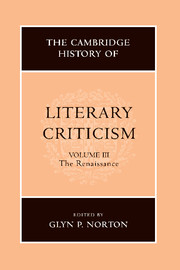Book contents
- Frontmatter
- Introduction
- READING AND INTERPRETATION: AN EMERGING DISCOURSE OF POETICS
- POETICS
- THEORIES OF PROSE FICTION
- CONTEXTS OF CRITICISM: METROPOLITAN CULTURE AND SOCIO-LITERARY ENVIRONMENTS
- VOICES OF DISSENT
- STRUCTURES OF THOUGHT
- NEOCLASSICAL ISSUES: BEAUTY, JUDGEMENT, PERSUASION, POLEMICS
- A SURVEY OF NATIONAL DEVELOPMENTS
- Bibliography
- Index
Introduction
Published online by Cambridge University Press: 28 March 2008
- Frontmatter
- Introduction
- READING AND INTERPRETATION: AN EMERGING DISCOURSE OF POETICS
- POETICS
- THEORIES OF PROSE FICTION
- CONTEXTS OF CRITICISM: METROPOLITAN CULTURE AND SOCIO-LITERARY ENVIRONMENTS
- VOICES OF DISSENT
- STRUCTURES OF THOUGHT
- NEOCLASSICAL ISSUES: BEAUTY, JUDGEMENT, PERSUASION, POLEMICS
- A SURVEY OF NATIONAL DEVELOPMENTS
- Bibliography
- Index
Summary
Criticism and crisis are etymological friends. Throughout history, literary criticism and cultural crisis have tended to follow convergent trajectories. Renaissance humanism, above all, was responsible for generating a language that would not only reflect the cultural crisis at hand, but base that crisis in its own distinctiveness as a period. The deepest, most central impulses of humanism are thus critical. If, as Frank Kermode asserts, crisis ‘is a way of thinking about one's moment, and not inherent in the moment itself’, then one may infer that crisis, and with it criticism, speak in a discourse peculiar to this temporal displacement. The critical temper, in its cultural as well as literary dimension, fixes the Renaissance view of time squarely within the Greek concept of κρí;σις [krisis] as designating a moment both of separation and of decision. The present volume has as its chief aim to register the discourse – the voices and modulations, as it were – of this moment.
The process by which Renaissance humanists sought to apply their systematic scholarly judgement to the encyclopaedia [decision] together with their sense of a time ripe for cultural reappraisal and self-identity [separation] is at the fulcrum of the literary-critical initiative that extended throughout the sixteenth and seventeenth centuries. The scale of this enterprise is complex and multiform. Strongly resistant to chronological segmentation as it is to enshrinement in ordered, self-contained units of critical activity, any history of reading – and that, arguably, is what this volume undertakes to scan for the period in question – founders on the temptation to ‘read’ the literary past as an edifice of integrated building stones, permanently set in critical mortar and in danger of collapse when the canon inscribed on those blocks is reconfigured by successive generations.
- Type
- Chapter
- Information
- The Cambridge History of Literary Criticism , pp. 1 - 22Publisher: Cambridge University PressPrint publication year: 1999
- 3
- Cited by



